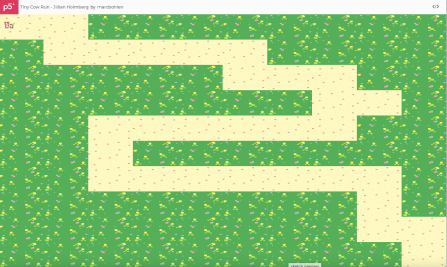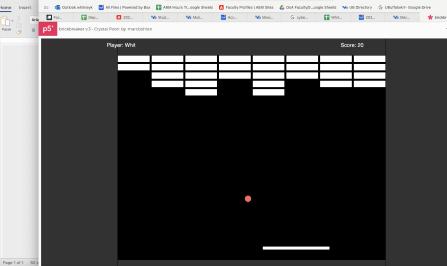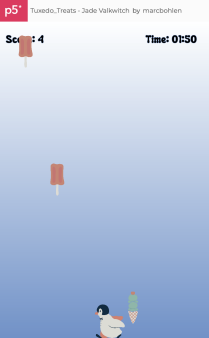Published February 3, 2025
Playable Student Mobile Games, Made in ART383 Interactive Art & Design
Professor Marc Böhlen's students created mobile games as their final project in the Fall 2024 semester.
Detail of Jillian Holmberg's "Tiny Cow Run"
Detail of Crystal Poon's "Brick Breaker"
Detail of Jade Valkwitch's "Tuxedo Treats"
Playable projects by students:
Crystal Poon: Brick Breaker
Code: https://editor.p5js.org/crystalpoon0718/full/WGRyjVtTk
Play: https://editor.p5js.org/marcbohlen/full/B5zL0oskY
Jillian Holmberg: Tiny Cow Run
Code: https://editor.p5js.org/jrholmberg10/sketches/AzciSzL7E
Play: https://editor.p5js.org/marcbohlen/full/e-7Tm_46t
Jade Valkwitch: Tuxedo Treats
Code: https://editor.p5js.org/jadevalk/full/GlaTor_MN
Play: https://editor.p5js.org/marcbohlen/full/j4fkQZgjS
(Note: 'Play' links directly to the playable mobile phone games)
The Assignment:
Interactive Art & Design
Students dive into the world of computationally mediated experiences to explore interaction strategies and concepts. Final projects can be in the domain of either data visualization or mobile phone games, topics addressed in the course.
This final assignment of the semester invited students to revisit previous P5 javascript work that produced a mobile phone playable game. The task was to bring that game framework to the next level.
What does “next level” mean?
It means refining the game concept. How does the game start, how does it unfold, how does it end?
Students were guided to consider the game feeling experience, and get feedback from a friend, to incorporate that knowledge into their revised versions. A description of how their game concept changed in this final version was included in the deliverables of the finished project.
Coding environment:
Javascript and P5: https://editor.p5js.org/
Deliverables:
A link to the P5.js project. Your project includes:
- A description of the game concept and the changes introduced from the first version.
- Modular code in separate .js files.
- Comments inside the code the explain what each section and function perform
- Visually appealing game assets.
The Course:
The ART383 undergraduate course introduces Art and Design students to interaction design, with a focus on conceptualizing and prototyping computationally mediated experiences. Readings include texts from theorists and practitioners of interaction design and students build toy systems that respond to the readings. Students will be asked to prepare short presentations on the assigned readings.
Interaction design is a wide field and this course uses the online Encyclopedia of Human-Computer Interaction as reference. From the many subfields of interaction, this course focuses on experience design, visualization, mobile and affective computing, context aware computing and environmental sensing.
Students will also explore the use of AI assistants to support project development and coding, and learn to use ChatGPT and Anthropic AI models to support their research and development activities.


